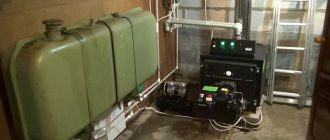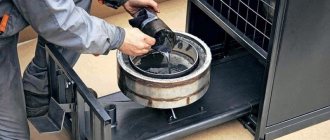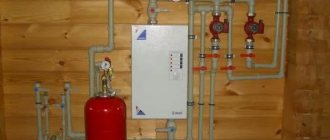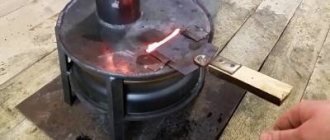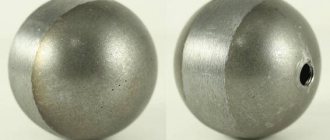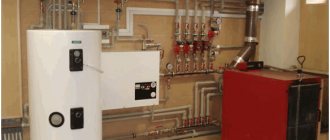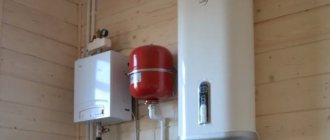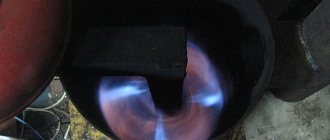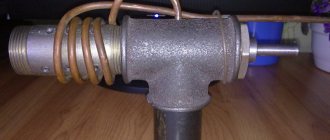Heating systems operating on waste oil are a popular alternative to units using conventional types of fuel. A waste oil boiler will help organize heating and hot water for dachas and country houses in areas remote from the benefits of civilization. Let’s figure out what types of devices are found on the market, what features they have, and what options are suitable for home use.
Model for a country house or cottage Source oboiman.ru
Advantages and disadvantages
The owners who decided to acquire a boiler for mining cite the following arguments in its favor:
- Practicality . The unit pays for itself already in the first heating season due to the low price of fuel. The equipment will cost even less if you assemble it yourself.
- Economical . Burning waste is cheaper than using gas, electricity, solid (coal, firewood) or diesel fuel, and pellets.
- Autonomy . The housing is not dependent on centralized heating and hot water supply systems.
- Environmental friendliness . Modern boilers from European and domestic manufacturers create less emissions than their solid fuel counterparts. Combustion products are non-toxic and do not pose a risk to the environment (provided the operation is properly configured).
- Quick warm up . Thanks to forced convection, the boiler quickly raises the temperature in the house.
- Reliability . The device has a simple design with a minimum set of parts. This reduces the likelihood of failure, which means increased reliability.
Automatic burner for large volumes of work Source bestpechi.ru
- Additional bonuses . Operation of the boiler during mining does not require constant human presence. It can be installed as a reserve for the main heating of the house.
The device has the following disadvantages:
- For the device, it is necessary to allocate a separate technical room with an effective ventilation system and fire protection.
- The unit requires regular, often daily, maintenance. The reason is the characteristics of the fuel containing impurities.
- Additional expenses. To extend the period of operation, the boiler is supplemented with a filter that retains impurities. When the filter becomes dirty, replace it with a new one.
- There are no non-volatile waste oil burners; they all need electricity, since according to technology, household devices for burning waste require pressurization and heating.
Scope of use
The first such units were developed in order to dispose of waste oil products (they were called that way: recyclers). They were designed so that the percentage of harmful emissions was minimal. A little later they figured out how to use the generated heat for heating, after which many modifications of the devices appeared.
Visual operating principle of the burner Source gwsigeps.com
Modern heat generators are varied in design; They are designed for heating the following premises:
- Car service centers, technical centers, hangars.
- Locksmith workshops, industrial premises, warehouses.
- Other industrial premises, private houses and summer cottages.
Any natural or synthetic waste oil, or a mixture of several oils, is suitable for use. The fuel can be oil:
- waste: motor, hydraulic, transmission, transformer (from machine tools and any equipment);
- drained from cars, hydraulic equipment, diesel locomotives;
- drained from a cooking unit (for example, a deep fryer);
- vegetable oils: rapeseed, soybean, corn, sunflower (waste);
- diesel fuel, kerosene.
- fuel oil, heating oil.
Where can I get oil?
The main suppliers of boiler oil are:
- motor transport enterprises;
- organizations owning railway, river or marine equipment;
- agricultural enterprises;
- car services;
- enterprises and organizations servicing hydraulic equipment;
- any organization that has a lot of cars on its balance sheet.
Any car needs to change the engine oil at least once a year; in addition, from time to time you have to change the lubricant in other equipment.
Disposal of waste petroleum products is legally very expensive , so suppliers of such material sell and often give it away for free in order to relieve themselves of the costs of storage and disposal.
Air heaters (calorifiers)
The burners used for processing are adapted for heating different types of coolant. Accordingly, although they run on liquid fuel, they are used in two ways: for air heating or heating water. Air heating devices are designed for heating industrial premises.
Waste oil steam boiler Source kpsk.ru
It is not advisable to use them in residential premises: during operation, the unit, despite the installed filter, emits the smell of machine oil. The heater has the following properties:
- Heats the premises of workshops, warehouses, car service centers with warm air, the temperature of which increases due to direct heating.
- The work is based on the drip-evaporation method of fuel combustion.
- The devices are designed for heating large rooms (for example, up to 3000 m³). Therefore, they are characterized by high performance and a large fuel tank volume (for example, 45-55 l).
- The heater is equipped with a high-power radial fan, so it effectively heats rooms with high ceilings.
- Modern models have additional capabilities, for example, a mechanical power regulator, accelerated ramp-up, and fine fuel purification.
Hot water boilers
Waste oil boilers with a water circuit are divided into two types:
- Single-circuit . They are intended for heating only.
- Dual-circuit . They are responsible for both heating and heating water for domestic needs.
The principle of operation of a waste oil boiler Source rinni-pool.ru
Structurally, the devices are divided into two types: pyrolysis and flare varieties.
Pyrolysis
The equipment is made of sheet steel; The main design elements are:
- Combustion chamber with water jacket.
- Remote oil pump and built-in fan.
- Control block.
The pyrolysis unit is compact in size, easy to install and reliable to use. Its central part is the firebox, surrounded by a jacket with coolant (water). The main feature of the design is the absence of a burner and the process in which preliminary evaporation of the fuel occurs. The pyrolysis apparatus functions as follows:
- The waste material is fed through a hose into an evaporation chamber made of thick sheet steel. There it is heated to the design temperature in the absence of oxygen.
- As the oil heats up, it decomposes, and decomposition products enter the combustion chamber.
- A perforated pipe is installed in the center of the chamber, through which air flows from the fan, so there is enough oxygen here.
- Under the action of a fan, partial combustion of the mixture is organized, which is intensively evaporated from the surface.
Industrial pyrolysis boiler Source bestpechi.ru
See also: Catalog of companies that specialize in engineering systems (heating, water supply, sewerage and others) and related work
- The mixture burns and heats the water jacket surrounding the chamber. The hot coolant (water) is used for its intended purpose, depending on the type of boiler (single- or double-circuit).
- The boiler is connected to a standard heating system with a circulation pump, expansion tank and radiators.
- The vapors are burned in a separate chamber, the combustion products are discharged through the ventilation to the street.
To adjust the combustion intensity, the air supply to the pyrolysis chamber is changed (that is, the pyrolysis temperature is changed). The design has at least two disadvantages:
- This principle does not make it possible to create an automatic device that can independently maintain the desired temperature in a room.
- As a result of pyrolysis of used oil, not only gaseous and volatile fractions are formed, which are beneficial, but also a heavy residue. It accumulates in the pyrolysis chamber, which is why the unit needs daily cleaning (sometimes the time between cleanings is reduced to several hours).
The pyrolysis boiler during production needs frequent cleaning Source satu.kz
Turbo burners (flare boilers)
Flare devices are considered more universal. They can be converted to use any liquid fuel: waste oil or diesel fuel, as well as waste oil products.
According to the principle of operation, turbo burners resemble diesel analogues:
- An oil-air mixture is created from the waste.
- The mixture under pressure passes through a nozzle, is sprayed in a special chamber to the state of fine droplets, and is ignited using electrodes.
- As the mixture burns, it transfers heat to the water circuit.
The devices have the following disadvantages:
- Sensitivity to fuel quality. If there are foreign impurities or water in the waste, the burner does not start.
- Requires high heating power. The waste does not ignite at room temperature; it is heated before spraying.
- Good quality turbo units cost money.
Heating boilers using waste oil for industrial and handicraft production are in most cases flare-type devices. Designs that implement partial evaporation of fuel are rarely used for heating cottages and country houses.
Diesel burner for drip boiler Source yandex.net
The advantages of a turbo burner only appear if it is used with a sealed boiler. This refers to a combustion chamber that is not directly connected to the surrounding air. In such a device, air enters through the burner (forced). Removal of waste combustion products occurs through a chimney (in domestic models) or through an outlet.
Thus, air is supplied only when the burner is on, and only forcedly (under pressure), which prevents gases from entering the combustion chamber into the room, and allows the unit to be operated with a sealed boiler, even if there is no natural draft.
Fuel features and design
Mining is considered a specific type of fuel. Not only does it contain unwanted impurities (that is, it is dirty), but it is also sticky in structure. This is due to the fact that additives are added to motor oils, the purpose of which is to coat rubbing surfaces with a thin layer. This improves the performance of the mechanism and protects it from premature wear in harsh conditions.
We can use any type of used oil Source vietnambiz.vn
Impurities make the fuel too viscous; it will not be able to mix evenly with the air and will clog the nozzle nozzle (in torch-type devices) or will not be able to distribute in an even layer over the spray head (in pyrolysis boilers).
Therefore, most waste oil heating burners operate by heating the mixture, which increases its fluidity.
Another feature of mining is that it is quite difficult to set fire to. The property required for motor oil (which, of course, should not ignite while the engine is running) makes it difficult to use in a boiler. Therefore, to ensure quick and reliable ignition of the waste, an electric spark (or gas torch) is used.
Another obstacle to the use of waste is its contamination with water or antifreeze (the latter can get into the oil from the engine cooling system). Organizing filtration is a rather labor-intensive and costly process. It will be justified where the boiler operates in constant mode to heat large rooms, and it can be constantly provided with exhaust (for example, in a large auto repair shop).
Universal Nortec burner for use in domestic and industrial heating boilers Source otoplenie-pro.com
If the burner is used irregularly during mining, it must have a design that is insensitive to solid impurities and water. For example, in some models the fuel line is connected to the sides of the unit; this reduces the likelihood of clogging.
Fire safety measures
It should be understood that such a home-made structure must be made strictly in accordance with established fire safety standards.
To protect the premises from fire, we also recommend adhering to the following rules:
- The chimney diameter must be at least 100 mm. Ideally, use sandwich pipes, on the surface of which a minimum amount of soot is formed.
- It is prohibited to store flammable items (fuel tanks) in the immediate vicinity of the tanks.
- All joints must be sealed.
- The thickness of the walls of the tanks where fuel combustion occurs must be at least 4 mm.
- To ensure the flow of fresh air into the room and to avoid smoke, it is necessary to equip the boiler room with a forced circulation system. The air exchange rate per 1 cubic meter of area is 180 m3/hour.
Domestic boilers under development
For private houses and cottages, heating boilers are used for testing, equipped with an automation system. Automatic heat generators have advanced capabilities. Automation helps to configure the operation of the unit, and does this in different ways, and also protects it from overheating. You can control the air temperature (by adjusting the power) and the heating mode of the coolant.
Domestic boilers are manufactured in a floor-standing version. The cost of an automatic device depends on the power, design features (with or without a nozzle burner), as well as on functionality. Craftsmen assemble the device themselves, and it costs much less.
Compact devices for home use Source prom.st
An exhaust boiler with a water circuit can be installed wherever water heating or hot water supply is required. Sometimes it is installed in parallel with existing boiler equipment to be used as a backup source.
Video description
About the construction of a homemade furnace for mining in the following video:
Organization of operation of a domestic boiler
Industrial waste oil boilers are high-tech equipment designed for use in heating systems for cottages and private houses. The designs of many devices offered on the Russian market are specially designed for operation in conditions of long and frosty winters (for example, units made in Russia, Finland, and Germany). The following properties are useful for everyday use:
- High efficiency. For some models it reaches 90%.
- The work takes place in a fully automatic mode. The burner and circulation pump are controlled through a convenient panel.
- High-quality models are made of heat-resistant boiler steel, which increases their reliability and service life.
Burner nozzle operation during exhaustion Source ytimg.com
- The design uses fuel heating technology; powerful filters are installed to trap mechanical impurities.
- Household appliances are equipped with a sealed fuel system, so there are no fumes or odors.
Many manufacturers equip their oil boilers with additional capabilities. For example, on some factory-assembled models it is possible to install a burner from any manufacturer. Other units have self-diagnosis capabilities and a triple burner restart function. After installing the boiler, the heating boiler will be able to meet the hot water supply needs of the house.
The operation of a domestic boiler during exhaust is ensured by the coordinated operation of all systems. The following components are distinguished in the flare type design:
- Oil pump . Connected to a preheating chamber, equipped with a coarse filter. The oil supply is automatic, may have protection against voltage loss, and an emergency sensor that monitors the boiler temperature.
Exhaust boilers are often installed in garages Source saucyintruder.org
Homemade boilers and the benefits of using waste
On the Internet you can find a lot of information on making heating boilers for mining on your own. However, it is necessary to understand that for use in domestic conditions, the use of only industrial units registered by Rostechnadzor is permitted.
Heating boiler being tested in a private house Source oboiman.ru
Homemade systems are functional, but potentially extremely dangerous. The fact is that a boiler that is safe to use at home is a technologically complex device. Therefore, most home-made models are structurally simplified and, for example, have a jet oil supply rather than a drip one.
When fuel is supplied in a jet, it most often does not have time to burn completely. As a result, toxic substances are formed. If the airtightness is weak, they can enter the premises, which will negatively affect health. Also, for a homemade unit, it is quite difficult to determine how profitable it is.
If it is necessary to calculate how much oil is required for an industrial boiler, use information from the technical documentation, which usually indicates fuel consumption per hour (in liters or kilograms). There are special programs (online calculators) that allow you to find out the consumption more accurately or taking into account adjustments (for example, the intensity of the flame or fuel supply).
Economical automatic boiler using waste oil Source rosclimate.com
Furnace design
Having seen in a video or photograph what this design looks like, you will immediately understand that anyone with straight arms can repeat this. The oil-powered unit consists of only two tanks - they are located at a distance from each other and connected only by a pipe.
The pipe has holes (rather large) located at a certain distance from each other. The lower element is used as a tank - you pour used oil into it, and primary ignition takes place there using gasoline/solvent or an ordinary rag/paper - it’s more convenient for you. After the oil has saturated, vapors begin to be released - they rise to the upper reservoir.
A violent combustion reaction occurs there, resulting in a huge amount of heat being generated. We recommend using thick sheets of iron to create a furnace, because the temperature of the impact on the material will be enormous. If the sheets are thin, then after the first launch the entire structure will be skewed and it will be impossible to use it.
Also, ready-made elements are often used to create such units. The most popular option is an old gas cylinder or metal barrels. The cylinder has thick walls, this design “lives” for a very long time and tolerates rough use. A barrel is easier to find than a gas cylinder, and it costs less, but it will work less well, because they often consist of rather thin sheets of iron.
Briefly about the main thing
Industrially manufactured household waste oil heating systems are popular due to their efficiency and reliability. Torch-type devices are suitable for use in a cottage or country house. They are effective and form a sealed working system, which makes them safe for health.
Domestic exhaust boilers are supplemented with one or two circuits. In the first case, they help to heat the house, in the second, they additionally heat water for domestic needs. Household units operate automatically; You can calculate fuel consumption using an online calculator or contact a specialist for a more accurate calculation.
Specifications
| Boiler room type | 0,24 | 0,3 | 0,4 | 0,5 | 0,6 | 0,7 | 0,8 | 1,0 | 1,24 | 1,6 | 1,7 | 1,9 | 2,0 | 2,4 | 2,6 | 2,8 | |
| Nominal heating capacity, MW (Gcal/hour) | 0,24 (0,21) | 0,3 (0,26) | 0,4 (0,34) | 0,5 (0,43) | 0,6 (0,52) | 0,7 (0,6) | 0,8 (0,69) | 1,0 (0,86) | 1,24 (1,06) | 1,6 (1,38) | 1,7 (1,46) | 1,9 (1,7) | 2,0 (1,72) | 2,4 (2,06) | 2,6 (2,24) | 2,8 (2,4) | |
| Power consumption, kW no more * | 3,0 | 3,7 | 4,3 | 5,8 | 8,0 | 11,0 | 11,7 | 12,2 | 13,0 | 16,0 | 20,0 | 22,0 | 23,0 | 24,0 | 25,0 | 26,0 | |
| Mains voltage, V | 220/380 | ||||||||||||||||
| Fuel | Waste oil | ||||||||||||||||
| Boiler room temperature, °C | 95 (115) — 70 | ||||||||||||||||
| Temperature of flue gases, at rated heating capacity, °C | 160-190 | ||||||||||||||||
| Efficiency factor (excluding losses in heating networks), % | 99,5 | ||||||||||||||||
| Boiler room operating mode | Automated | ||||||||||||||||
| Overall dimensions of the boiler room, m | 7,2×2,45×3,1 | 8,6×2,4×3,2 | 4,8×7,2×3,2 | 7,2×7,2×3,2 | 9,6×7,2×3,2 | ||||||||||||
